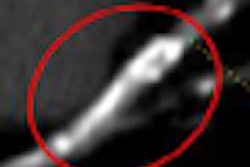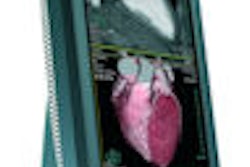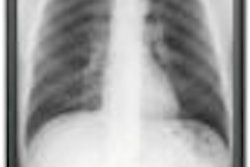VIENNA - Three-dimensional images from normal coronary CT angiography (CTA) scans are highly sensitive for detecting fixed perfusion defects compared to myocardial SPECT. A special reconstruction technique performed with customized software does the job without the need for additional radiation or contrast.
So concludes a joint study from the University of Chicago in Illinois and the University of Bologna in Italy presented Saturday at the European Congress of Radiology (ECR).
CT has proved its ability to detect perfusion abnormalities associated with myocardial infarction, based on visual examination of 2D image slices. But it's quite another thing to provide a 3D quantitative analysis of myocardial perfusion based on CT data, according to principal investigator Nadjia Kachenoura, Ph.D., from the University of Chicago.
Kachenoura and colleagues sought to "develop software for the volumetric analysis of myocardial perfusion from MDCT images acquired for CTA, and to test its ability to correctly determine the location, extent, and severity of perfusion defects against SPECT," she said.
The researchers examined 44 patients (31 men and 13 women; mean age, 62 years) who were referred for coronary CT angiography. The cohort included 15 controls with normal myocardial perfusion imaging (MPI) and no significant stenosis at coronary CTA, as well as a study group consisting of 14 patients with normal perfusion and 15 patients with six irreversible perfusion defects on myocardial perfusion SPECT.
MDCT datasets were acquired on a 64-detector-row scanner according to a standard protocol. The images "were converted into a stack of short-axis slices with 1-mm thickness ... and were exported for offline analysis with a custom software [application] which detects semiautomatically endocardial and epicardial borders," she said.
The software generates a "bull's-eye" display of myocardial perfusion that is color-coded similarly to SPECT results. It calculated a quantitative index of the extent and severity of perfusion abnormality, which the researchers deemed QH, for 16 volumetric segments.
They visually inspected the color-coded MDCT-derived bull's-eyes and compared them with resting myocardial perfusion SPECT scores per segment, artery, and patient. The quantitative MDCT perfusion data were then correlated with rest MPI summed scores and used for objective detection of perfusion defects.
The results showed that MDCT-derived bull's-eyes accurately reflected perfusion defects in agreement with MPI (kappa = 0.70 by territory, 0.79 by patient).
"Importantly, no abnormal patient was missed by MDCT quantitative analysis. ... Overall, good levels of agreement were obtained against resting [SPECT MPI] in segment territory and especially on a segment basis," Kachenoura said.
The quantitative data also agreed with SPECT results by all three measures:
- Correlation between summed QH and MPI scores: 0.87 (territory), 0.84 (patient)
- Area under receiver operator characteristics (ROC) curve of 0.87
- Sensitivity of 79% to 92%, specificity of 83% to 91%, and accuracy of 83% to 89% for the objective detection of perfusion defects
A new technique for volumetric analysis of MDCT images, tested against rest myocardial perfusion SPECT, is feasible and allows accurate, objective detection of fixed perfusion defects, Kachenoura said.
"Both qualitative and quantitative perfusion information may aid in elucidating the significance of coronary lesions when combined with stress," she said. "Because coronary stenosis and perfusion abnormalities are not identical but rather complimentary, MDCT perfusion may become a valuable addition to CT angiography for noninvasive evaluation of [coronary artery disease] without additional radiation or contrast dose."
By Eric Barnes
AuntMinnie.com staff writer
March 8, 2009
Related Reading
Cardiac stress MR tops SPECT, showing cause of chest pain, November 30, 2008
Adenosine stress DECT equivalent to SPECT, MRI, November 21, 2008
MRI evaluation of chest pain cuts acute coronary syndrome, August 15, 2008
MR-IMPACT trial: CMR equivalent to SPECT for stenosis detection, February 18, 2008
Cardiac MR measures predict pulmonary hypertension, April 9, 2007
Copyright © 2009 AuntMinnie.com



















